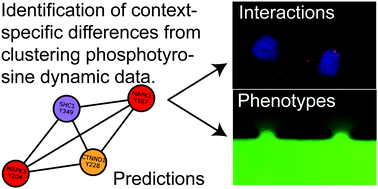Ensemble clustering of phosphoproteomic data identifies differences in protein interactions and cell–cell junction integrity of HER2-overexpressing cells†
Abstract
Overexpression of HER2, a receptor tyrosine kinase of the ERBB family, in breast cancer is related to increased cancer progression and aggressiveness. A breast epithelial cell model with the single perturbation of HER2 overexpression is capable of replicating the increased aggressiveness of HER2 overexpressing cancers. In previous work, Wolf-Yadlin and colleagues (Wolf-Yadlin et al., Mol. Syst. Biol., 2006, 2) measured the proximal tyrosine phosphorylation dynamics of the parental and HER2 overexpressing cells (24H) in response to EGF. Here, we apply an ensemble clustering approach to dynamic phosphorylation measurements of the two cell models in order to identify signaling events that explain the increased migratory potential of HER2 overexpressing cells. The use of an ensemble approach for identifying relationships within a dataset and how these relationships change across datasets uncovers relationships that cannot be found by the direct comparison of dynamic responses in the two conditions. Of particular note is a drastic change in the clustering of SHC1 phosphorylation (on site Y349) from an EGFR-MAPK module in parental cells to a module consisting of an E-cadherin junction protein phosphorylation site, catenin delta-1 Y228, in HER2 overexpressing (24H) cells. Given the importance of E-cadherin junctions in healthy epithelial wound healing and migration, we chose to test the computationally-derived identification of altered cell junctions and CTNND1:SHC1 relationships. Our cell and molecular biology experiments demonstrate that SHC and CTNND1 interact in an EGF- and HER2-dependent manner and that the cell junctions are phenotypically affected by HER2, breaking down in response to EGF and yet avoiding apoptosis as a result of cell junction loss. The results suggest a mechanism by which HER2 alters the localization of the SHC-MAPK signaling axis and a phenotypic effect on cell junction integrity.



 Please wait while we load your content...
Please wait while we load your content...